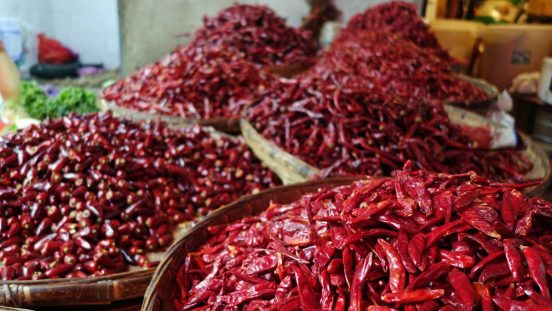Guiyang, the capital of Guizhou, is an odd place. Not much of it feels very modern, not much of it is old.
In between those two, it is a fascinating place – certainly for me, for the search for red hot China.
Guiyang’s markets alone give an impression of the diversity of chilli used in this province; the food also did its part.
And I had some special reasons to want to visit Guiyang: an encounter with Huaxi chilli, a look at ciba lajiao, Guizhou’s version of laziji – and Jill-Marie of Guiyang Bites, who has experience from years living here!
As usual, between online maps and good endurance, I found markets that were of interest…
Huaxi Chilli
Funnily, although Huaxi is a district of the city of Guiyang, and Huaxi chilli is a chile pepper with protected geographical designation (i.e., has to be grown in that area), it was not easy to find.
Online, I found this information about it and a mention that it should actually be considered a sub-type of erjingtiao.
This famous Sichuan chilli is essential for the cuisine of that northern neighbor of Guizhou. Pixian douban, for example, uses erjingtiao.
Most of the erjingtiao chilli used in Sichuan, though, is actually grown in Guizhou.
Only one chile seller among several of them, in one big outdoor ‘wet’ market, had Huaxi chilli.

Apparently, even Guizhou people consider it rather similar to other types of chilli. Maybe it is a bit better, but it is definitely also more expensive. Hence, less demand, fewer sellers – at least at the markets I found.
Huaxi Niurou Fen – Huaxi Beef Noodle Soup
Huaxi is also, and perhaps better, known for the beef noodle soup that comes from there.
The way things often go with such foods in China these days, that means there’s a restaurant chain serving Huaxi beef noodle soup.

Of course I tried it out, temperatures having been a bit chilly.
It sure was warming and nice enough.

It also had the typical problem of famous beef noodle soups in China: Many towns have their special versions. And to the uninitiated, which I definitely am when it comes to these, the differences between them are less than non-apparent.
Guizhou’s Special Chilli
With the chilli, the differences are greater – to me, at least.
Even so, they are not always easy to tell apart unless someone confirms – or simply says – what’s what.
Guizhou has another peculiarity with the chilli, though. For Guizhou cuisine, one finds a lot of “burnt” hu lajiao. And ciba lajiao.
Hu Lajiao, “Burnt” Chilli
Hu lajiao is most commonly found as dried chilli flakes. They are not just dried and crushed, however.

For making hu lajiao, the chilli is first roasted.
As I came across it in some places, that roasting is sometimes done on a hot griddle, a lot like chilli skin is blistered to remove it.
Sometimes, as I found it in one of Guiyang’s markets, the fresh chilli is simply put above a flame.


With this freshly scorched chilli, a way of making and using hu lajiao is also to crush the “burnt” fresh chilli and use it immediately.
Ciba Lajiao
Ciba lajiao, which we will have a look at making, is a peculiar way of getting from dried chilli back to a chilli paste.
For this, the dried chilli is soaked in hot water, drained, and – certainly in the markets – put through the (meat) grinder.

The ciba lajiao, excess liquid fried off in a pan, forms the foundation of Guizhou’s version of laziji.
Guizhou Laziji
Where Sichuan and Chongqing make laziji with an abundance – mounds, I should say – of dried chilli (which is not to be eaten), Guizhou people make it with ciba lajiao.
Used a lot like Pixian douban, it serves as the base for a paste or sauce of spicy chilli which coats the chicken pieces (and often, potato cubes).
It’s hard to photograph in its dark red; it’s not for the weak who are unused to chilli – and it’s not horribly hot, either, but extremely tasty.


Ciba and Ciba Lajiao
In one restaurant, I tried Guizhou laziji together with a dish of ciba.
That’s hardly a meal, but I like ciba – and it’s the namesake of the ciba lajiao.
Ciba by itself is a rice cake made of glutinous rice.
The rice is cooked, then pounded into a paste (a lot like mochi).
Ciba are shaped into the shape of flattened balls or sticks and coated in soybean flour (or, in that restaurant, alternatively in purple yam or something like that).
These ciba cakes apparently, because of the similarity in preparation and/or texture, gave their name to the ciba lajiao of Guizhou.

Other foods… I think we’ll need a post of its own for those!




Leave a Reply
You must be logged in to post a comment.